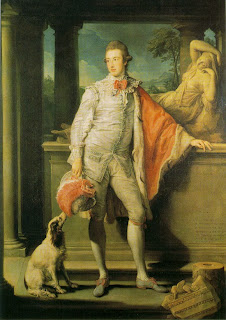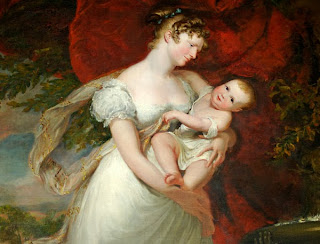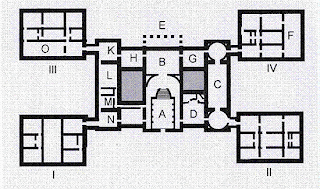I loved Holkham Hall!!! Frankly I had suspected it might be a letdown, an anticlimax after the brilliance of Houghton Hall. I feared the comparison of back-to-back days at two stately homes would disappoint me in the second — and frankly, I had longed to see Holkham much longer than I yearned for Houghton — if that makes any sense. But I needn’t have worried.
The Holkham Hall Estate website is here.
Holkham Hall
Magnificent is the word most frequently used to describe Holkham and the building surely lives up to its reputation as among the finest Palladian buildings in the realm. And it has the added attraction of having been the home of a distinguished English gentleman, Thomas William Coke (1754-1842), MP and agricultural innovator, later named (at age 83) to the revived title of the Earl of Leicester of Holkham.
portrait of Thomas William Coke (pronounced Cook)
I admit that one of my favorite things about Holkham is that pictures are allowed everywhere. I find it hard to understand why people restrict taking pictures of their premises, whether stately homes, museums, or whatever, as today’s digital cameras usually don’t need flash. Seems needlessly restrictive. Of course, when pictures are allowed, some people (moi?) will take too many! As of the incredible Marble Hall, just inside the entrance to Holkham Hall.
50+ foot ceiling
I really found it hard to stop finding new perspectives to snap. I really needed a wide-angle lens, didn’t I? Even though it is named Marble Hall, the material used was actually Derbyshire Alabaster.
Visitors entering Holkham Hall
Over the door, Lady Leicester placed this sign, referring to
Thomas Coke, the great-uncle of Coke of Norfolk; they shared the same name and title Sometimes it can be confusing as to which Thomas Cook, Earl of Leicester, is which.
A Marble Bust of Coke of Norfolk
Column Base, of Derbyshire Alabaster
The family fortune was founded in the time of Henry VIII by Sir Edward Coke (1552-1634), Lord Chief Justice in the reign of James I. A century later, Sir Edward’s descendant Thomas Coke
(1697–1759) built Holkham Hall for his family and to house his collection of art acquired on his grand tour; he was created lst Earl of Leicester of the Fifth Creation in 1744. Since his only son died young, the heir to Holkham Hall was his nephew Wenman Coke, father of Thomas William Coke.
&
nbsp;
Thomas Coke, ca. 1715, painted by Francesco Trevisani (1656–1746), in Italy
The Thomas Coke above shared many experiences and concepts with the men responsible for the Palladian “revolution” in England in the early to mid 18th century, from their days on the Grand Tour: Richard Boyle, 3rd Earl of Burlington (1694–1753); architect Colen Campbell (1676–1729) author of Vitruvius Britannicus, or the British Architect 1715-1725; and William Kent (c.1685–1748), architect and furniture designer, among others. These men were also largely responsible for nearby Houghton Hall, visited in the two previous posts in this series.
Holkham Hall
‘Palladian’ refers to the architecture of Andrea Palladio (1508–1580), whose work in the Veneto region of Italy was based on the principles of proportion and symmetry of ancient Greek and Roman temples. A brief taste of this style appeared in England in the work of Inigo Jones (1573–1652), but was not revived until long after the Civil War was over in 1660 (e.g. the Banqueting House, Whitehall; The Queen’s House, Greenwich; and Covent Garden’s St. Paul’s Church).
After the 1st Earl of Leicester died in 1759, his widow lived at Holkham until her death in 1775. The estate then passed to the nephew Wenman, who lived there for only a few months before dying in 1776. His son, Thomas William Coke (the future Coke of Norfolk) thus inherited the Holkham estate at age 22, after taking the Grand Tour.
Coke of Norfolk grew up on his father Wenman Roberts Coke’s estate in Derbyshire, much smaller than Holkham, but a good grounding for a man who dedicated his life to agriculture — and to political affairs.
Thomas William Coke, 1774, by Pompeo Batoni (1708–1787)
Thomas William Coke did little to change the grand house of his esteemed great uncle. Instead, he turned his considerable energies to agriculture and politics. He served in the House of Commons for many years, aligning himself mostly with the great land owners in the Whig Party. He was an M.P. for Norfolk from 1776-1784, then again represented Norfolk between 1790 and 1832.
Coke of Norfolk by Ramsay Richard Reinagle, 1815
Thomas William Coke’s first wife was Jane Dutton (1753-1800) with whom he had three
daughters, Ladies Jane, Anne, and Elizabeth. After his wife’s death, Coke was a widower for many years. At the age of 68 in 1822 he married Lady Anne Keppel (1803-1844), age eighteen. This September-May union led to the birth of several more children, including a male heir, Thomas William Coke (1822-1909), who became the second Earl of Leicester of the second creation.
Lady Anne Coke, Countess of Leicester, and son Thomas, b. 1822
North State Dining Room
North State Dining Room
The Guidebook to Holkham Hall describes this room as having “austere splendor” but I must say I’d rather have dinner with the Earl at this lovely round table than at a long narrow one. Unfortunately our invitation got lost in the mail. Truly a pity.
Plan of Holkham Hall
The Marble Hall is A in the plan above, the North Dining Room is D. The Saloon, below is B.
The Saloon
Among the brilliant paintings in the house, the Van Dyke equestrian portrait of the Duc d’Arenberg is one of the most famous. Below is the doorway into the Marble Hall from the Saloon.
Looking into the Marble Hall from the Saloon
The inviting Library in the Family Wing (F)
The Landscape Room (K)
Most of these priceless paintings were originally purchased by (the first) Thomas Coke on his Grand Tour. Included are works by Poussin, Claude, Grimaldi, Rosa, and others.
The Stunning Parrot Bedroom
The Parrots, for whom the room is named
The handsome Chapel (O)
Stunning Cooper pans and bowls
The gigantic kitchen fireplace, large enough to roast an ox
I have run out of superlatives to describe the interior of Holkham Hall, so I will close for the time being, and leave a few more features of the estate for Part Two, coming soon.
.jpg)


